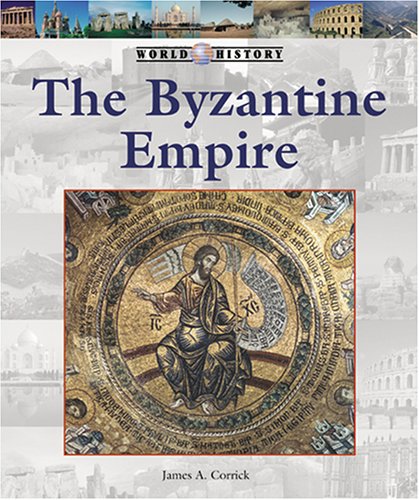-
The Byzantine Empire
Jennifer Ann Fretland VanVoorst, Richard Greenfield
Paperback (Compass Point Books, Aug. 1, 2012)The Byzantine Empire, which thrived from 395 to 1453, was a fascinating place. Its people thought of themselves as Romans, spoke Greek, and hailed from all across Europe and Asia. Centered in today's Istanbul, it was a Christian empire that preserved and developed Europe's intellectual heritage at a time when western Europe was in decline. V
V
-
The Byzantine Empire
James A Corrick
Hardcover (Lucent, Feb. 17, 2006)Presents the history, politics, religion, culture, and reasons for the fall of the Byzantine Empire. Z
Z
-
The Byzantine Empire
James A. Corrick
Library Binding (Lucent Books, Jan. 1, 1997)A historical overview of the cultural phenomenon of the Byzantine Empire and its legacy. V
V
-
The Byzantine Empire
Carolyn DeCarlo
Library Binding (Rosen Education Service, Jan. 15, 2018)Throughout the Middle Ages, various empires reigned across Europe and Asia; a closer look at these empires proves their enduring impact on the world. The Byzantine Empire lasted for more than one thousand years and was one of the world's leading civilizations until its decline in the eleventh century C.E. In this insightful, straightforward text, readers will be led through the rise, the golden age, and the fall of the empire, including the creation of Constantinople and its connection to the Easter Orthodox Christian religion. This immersive book incorporates references to concurrent empires, such as the Ottoman Turks. S
S
-
The Byzantine Empire
Jennifer Ann Fretland VanVoorst, Richard Greenfield
Library Binding (Compass Point Books, Aug. 1, 2012)The Byzantine Empire, which thrived from 395 to 1453, was a fascinating place. Its people thought of themselves as Romans, spoke Greek, and hailed from all across Europe and Asia. Centered in today's Istanbul, it was a Christian empire that preserved and developed Europe's intellectual heritage at a time when western Europe was in decline. V
V
-
The Byzantine Empire
Carolyn DeCarlo
Paperback (Rosen Education Service, Jan. 15, 2018)Throughout the Middle Ages, various empires reigned across Europe and Asia; a closer look at these empires proves their enduring impact on the world. The Byzantine Empire lasted for more than one thousand years and was one of the world's leading civilizations until its decline in the eleventh century C.E. In this insightful, straightforward text, readers will be led through the rise, the golden age, and the fall of the empire, including the creation of Constantinople and its connection to the Easter Orthodox Christian religion. This immersive book incorporates references to concurrent empires, such as the Ottoman Turks. V
V
-
The Byzantine Empire
Mary Griffin
Paperback (Gareth Stevens Publishing, Aug. 15, 2019)Byzantine art and architecture are admired throughout the world, but many people are less familiar with the influential empire that produced it. Young historians will learn about the world power that was born out of the Roman Empire and lasted nearly 1,000 years after Rome fell. They'll read about important rulers such as Justinian and Constantine and how the Crusades finally caused the destruction of the mighty domain. Aspects of culture such as religion, art, and architecture are explained and beautifully displayed in the featured full-color artwork. S
S
-
Byzantine Empire
Mary Boone
Library Binding (Mitchell Lane Publishers, June 15, 2012)The culture and history of ancient Ancient Byzantine is presented in this title intended for readers ages 8-12 years old. Y
Y
-
The Culture of the Byzantine Empire
Vic Kovacs
Paperback (PowerKids Press, Aug. 15, 2016)Constantinople was once known as the city of the world, but this was only one important settlement in the Byzantine Empire. This title explores the geographical reaches of the eastern part of the Roman Empire, with a focus on the multicultural people who made it their home. The text covers the lives of Christians, Jews, and Muslims, as well as the merchants, Viking mercenaries, and barbarian hordes that made this culture unique. Other important social studies topics include arts, architecture, education, and family life. Readers will be fascinated by the ancient world of the Byzantines. R
R
-
The Culture of the Byzantine Empire
Vic Kovacs
Library Binding (PowerKids Press, Aug. 15, 2016)Constantinople was once known as the city of the world, but this was only one important settlement in the Byzantine Empire. This title explores the geographical reaches of the eastern part of the Roman Empire, with a focus on the multicultural people who made it their home. The text covers the lives of Christians, Jews, and Muslims, as well as the merchants, Viking mercenaries, and barbarian hordes that made this culture unique. Other important social studies topics include arts, architecture, education, and family life. Readers will be fascinated by the ancient world of the Byzantines. R
R
-
The Rise and Fall of the Byzantine Empire
Monique Vescia
Paperback (Rosen Young Adult, Aug. 15, 2016)Follows the historical backdrop of the Byzantine Empire, discussing the leaders, how they helped the empire flourish, and how the Byzantine society shaped the world.
-
The Rise and Fall of the Byzantine Empire
Monique Vescia
Library Binding (Rosen Young Adult, Aug. 15, 2016)Growing on the heels of the collapse of the Roman Empire, the Byzantine Empire was in some ways a continuation of its predecessor, extending its history for another 1,000 years. With a new capital at Constantinople, however, it also had a distinctly Eastern character of its own. Readers are transported to Byzantium in this absorbing volume, which recounts the history of this brilliant and articulate civilization as well as the many cultural and architectural achievements it spawned before falling to the Ottomans in 1453. Seminal events are covered in depth in the text and also highlighted in a timeline.